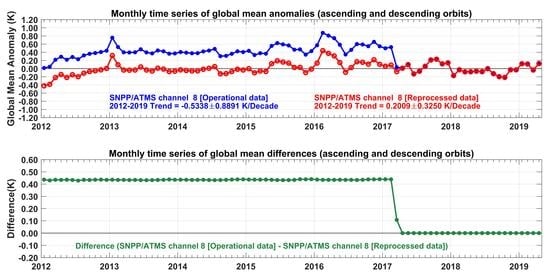The Reprocessed Suomi NPP Satellite Observations
Abstract
1. Introduction
2. ATMS Reprocessing
2.1. The Instrument and Calibration Principles
2.2. Consistency and Stability of Reprocessed ATMS Data
3. CrIS Reprocessing
3.1. The Instrument and Calibration Principles
3.2. Consistency and Stability of Reprocessed CrIS Data
4. OMPS Reprocessing
4.1. The Instruments and Calibration Principles
4.2. Consistency and Stability of Reprocessed OMPS Data
5. VIIRS Reprocessing
5.1. The Instrument and Calibration Principles
5.2. Consistency and Stability of Reprocessed VIIRS Data
6. Conclusions
Author Contributions
Funding
Acknowledgments
Conflicts of Interest
Disclaimer
References
- Derber, J.C.; Wu, W.-S. The use of TOVS cloud-cleared radiances in the NCEP SSI analysis system. Mon. Weather Rev. 1998, 126, 2287–2299. [Google Scholar] [CrossRef]
- English, S.J.; Renshaw, R.J.; Dibben, P.C.; Smith, A.J.; Rayer, P.J.; Poulsen, C.; Saunders, F.W.; Eyre, J.R. A comparison of the impact of TOVS and ATOVS satellite sounding data on the accuracy of numerical weather forecasts. Q. J. R. Meteorol. Soc. 2000, 126, 2911–2931. [Google Scholar]
- Thépaut, J.-N. Satellite data assimilation in numerical weather prediction: An overview. In Proceedings of the Annual Seminar on Recent Developments in Data Assimilation for Atmosphere and Ocean, ECMWF, Reading, UK, 8–12 September 2003; pp. 75–94. [Google Scholar]
- Lorenc, A.C.; Marriott, R.T. Forecast sensitivity to observations in the Met Office Global NWP system. Q. J. R. Meteorol. Soc. 2014, 140, 209–224. [Google Scholar] [CrossRef]
- Spencer, R.W.; Christy, J.R. Precision and radiosonde validation of satellite gridpoint temperature anomalies. Part I: MSU Channel 2. J. Clim. 1992, 5, 847–857. [Google Scholar] [CrossRef]
- Christy, J.R.; Spencer, R.W.; Norris, W.B.; Braswell, W.D. Error estimates of version 5.0 of MSU-AMSU bulk atmospheric temperature. J. Atmos. Oceanic Technol. 2003, 20, 613–629. [Google Scholar] [CrossRef]
- Mears, C.A.; Schabel, M.C.; Wentz, F.J. A reanalysis of the MSU channel 2 tropospheric temperature record. J. Clim. 2003, 16, 3650–3664. [Google Scholar] [CrossRef]
- Mears, C.A.; Wentz, F.J. Sensitivity of satellite-derived tropospheric temperature trends to the diurnal cycle adjustment. J. Clim. 2016, 29, 3629–3646. [Google Scholar] [CrossRef]
- Zou, C.-Z.; Goldberg, M.; Cheng, Z.; Grody, N.; Sullivan, J.; Cao, C.; Tarpley, D. Recalibration of microwave sounding unit for climate studies using simultaneous nadir overpasses. J. Geophys. Res. 2006, 111, 1–24. [Google Scholar] [CrossRef]
- Zou, C.-Z.; Wang, W. Inter-satellite calibration of AMSU-A observations for weather and climate applications. J. Geophys. Res. Atmos. 2011, 116, 1–20. [Google Scholar] [CrossRef]
- Santer, B.D.; Bonfils, C.J.W.; Fu, Q.; Fyfe, J.C.; Hegerl, G.C.; Mears, C.; Painter, J.F.; Po-Chedley, S.; Wentz, F.J.; Zelinka, M.D.; et al. Celebrating the anniversary of three key events. Nat. Clim. Chang. 2019, 9, 180–182. [Google Scholar] [CrossRef]
- Wang, L.; Zou, C.-Z.; Qian, H. Construction of stratospheric temperature data records from Stratospheric Sounding Units. J. Clim. 2012, 25, 2931–2946. [Google Scholar] [CrossRef]
- Thompson, D.W.J.; Seidel, D.J.; Randel, W.J.; Zou, C.-Z.; Butler, A.H.; Mears, C.; Osso, A.; Long, C.; Lin, R. The mystery of recent stratospheric temperature trends. Nature 2012, 491, 692–697. [Google Scholar] [CrossRef] [PubMed]
- Zou, C.-Z.; Qian, H.; Wang, W.; Wang, L.; Long, C. Recalibration and merging of SSU observations for stratospheric temperature trend studies. J. Geophys. Res. Atmos. 2014, 119, 13,180–13,205. [Google Scholar] [CrossRef]
- Zou, C.-Z.; Qian, H. Stratospheric temperature climate data record from merged SSU and AMSU-A observations. J. Atmos. Ocean. Tech. 2016, 33, 1967–1984. [Google Scholar] [CrossRef]
- Randel, W.J.; Smith, A.K.; Wu, F.; Zou, C.-Z.; Qian, H. Stratospheric temperature trends over 1979–2015 derived from combined SSU, MLS and SABER satellite observations. J. Clim. 2016, 29, 4843–4859. [Google Scholar] [CrossRef]
- Seidel, D.J.; Li, J.; Mears, C.; Moradi, I.; Nash, J.; Randel, W.J.; Saunders, R.; Thompson, D.W.J.; Zou, C.-Z. Stratospheric temperature changes during the satellite Era. J. Geophys. Res. 2016, 121, 664–681. [Google Scholar] [CrossRef]
- Cavalieri, D.J.; Gloersen, P.; Parkinson, C.L.; Comiso, J.C.; Zwally, H.J. Observed hemispheric asymmetry in global sea ice changes. Science 1997, 278, 1104–1106. [Google Scholar] [CrossRef]
- Comiso, J.C.; Meier, W.N.; Gersten, R. Variability and trends in the Arctic Sea ice cover: Results from different techniques. J. Geophys. Res. Oceans 2017, 122, 6883–6900. [Google Scholar] [CrossRef]
- Leuliette, E.; Nerem, R.; Mitchum, G. Calibration of TOPEX/Poseidon and Jason altimeter data to construct a continuous record of mean sea level change. Mar. Geodesy 2004, 27, 79–94. [Google Scholar] [CrossRef]
- Nerem, R.S.; Chambers, D.P.; Choe, C.; Mitchum, G.T. Estimating mean sea level change from the TOPEX and Jason altimeter missions. Mar. Geodesy 2010, 33, 435–446. [Google Scholar] [CrossRef]
- Nerem, R.S.; Beckley, B.D.; Fasullo, J.T.; Hamlington, B.D.; Masters, D.; Mitchum, G.T. Climate-change–driven accelerated sea-level rise detected in the altimeter era. Proc. Natl. Acad. Sci. USA 2018, 115, 2022–2025. [Google Scholar] [CrossRef] [PubMed]
- Ablain, M.; Legeais, J.F.; Prandi, P.; Marcos, M.; Fenoglio-Marc, L.; Dieng, H.B.; Benveniste, J.; Cazenave, A. Satellite altimetry-based sea level at global and regional scales. Surv. Geophys. 2017, 38, 9–33. [Google Scholar] [CrossRef]
- Chen, X.; Zhang, X.; Church, J.A.; Watson, C.S.; King, M.A.; Monselesan, D.; Legresy, D.B.; Harig, C. The increasing rate of global mean sea-level rise during 1993–2014. Nat. Clim. Chang. 2017, 7, 492–495. [Google Scholar] [CrossRef]
- Thompson, P.R.; Merrifield, M.A.; Leuliette, E.; Sweet, W.; Chambers, D.P.; Hamlington, B.D.; Jevrejeva, S.; Marra, J.J.; MItchum, G.T.; Nerem, R.S.; et al. Sea level variability and change [in “State of the Climate in 2017”]. Bull. Am. Meteorol. Soc. 2018, 99, S84–S87. [Google Scholar]
- Saha, S.; Moorthi, S.; Pan, H.L.; Wu, X.; Wang, J.; Nadiga, S.; Tripp, P.; Kistler, R.; Woollen, J.; Behringer, D.; et al. The NCEP climate forecast system reanalysis. Bull. Am. Meteorol. Soc. 2010, 91, 1015–1058. [Google Scholar] [CrossRef]
- Rienecker, M.M.; Suarez, M.J.; Gelaro, R.; Todling, R.; Bacmeister, J.; Liu, E.; Bosilovich, M.G.; Schubert, S.D.; Takacs, L.; Kim, G.K.; et al. MERRA—NASA’s Modern-Era Retrospective Analysis for Research and Applications. J. Clim. 2011, 24, 3624–3648. [Google Scholar] [CrossRef]
- Dee, D.P.; Uppala, S.M.; Simmons, A.J.; Berrisford, P.; Poli, P.; Kobayashi, S.; Andrae, U.; Balmaseda, M.A.; Balsamo, G.; Bauer, D.P.; et al. The ERA-Interim reanalysis: Configuration and performance of the data assimilation system. Q. J. R. Meteorol. Soc. 2011, 137, 553–597. [Google Scholar] [CrossRef]
- Kobayashi, S.; Ota, Y.; Harada, Y.; Ebita, A.; Moriya, M.; Onoda, H.; Onogi, K.; Kamahori, H.; Kobayashi, C.; Endo, H.; et al. The JRA-55 Reanalysis: General specifications and basic characteristics. J. Meteorol. Soc. Jpn. 2015, 93, 5–48. [Google Scholar] [CrossRef]
- Fujiwara, M.; Wright, J.S.; Manney, G.L.; Gray, L.J.; Anstey, J.; Birner, T.; Davis, S.; Gerber, E.P.; Harvey, V.L.; Hegglin, M.I.; et al. Introduction to the SPARC Reanalysis Intercomparison Project (S-RIP) and overview of the reanalysis systems. Atmos. Chem. Phys. 2017, 17, 1417–1452. [Google Scholar] [CrossRef]
- Goldberg, M.D.; Kilcoyne, H.; Cikanek, H.; Mehta, A. Joint Polar Satellite System: The United States next generation civilian polar-orbiting environmental satellite system. J. Geophys. Res. Atmos. 2013, 118, 13463–13475. [Google Scholar] [CrossRef]
- Zhou, L.; Divakarla, M.; Liu, X. An Overview of the Joint Polar Satellite System (JPSS) Science Data Product Calibration and Validation. Remote Sens. 2016, 8, 139. [Google Scholar] [CrossRef]
- Zhou, L.; Divakarla, M.; Liu, X.; Layns, A.; Goldberg, M. An overview of the science performances and calibration. Validation of joint polar satellite system operational products. Remote Sens. 2019, 11, 698. [Google Scholar] [CrossRef]
- NOAA/STAR. Workshop Report on JPSS Life-Cycle Data Reprocessing to Advance Weather and Climate Applications. Available online: https://www.star.nesdis.noaa.gov/star/documents/meetings/JPSS2016_LDRW/NPSSLifeCycleDataReprocessingWorkshopSummary.pdf (accessed on 28 July 2020).
- National Research Council. Climate Data Records from Environmental Satellites: Interim Report; The National Academies Press: Washington, DC, USA, 2004; p. 135. [Google Scholar]
- Chen, R.; Cao, C.; Menzel, P.W. Intersatellite calibration of NOAA HIRS CO2 channels for climate studies. J. Geophys. Res. 2013, 118, 5190–5203. [Google Scholar]
- Menzel, W.P.; Frey, R.A.; Borbas, E.E.; Baum, B.A.; Cureton, G.; Bearson, N. Reprocessing of HIRS Satellite Measurements from 1980 to 2015: Development toward a Consistent Decadal Cloud Record. J. Appl. Meteor. Climatol. 2016, 55, 2397–2410. [Google Scholar] [CrossRef]
- Stowe, L.L.; Jacobowitz, H.; Ohring, G.; Knapp, K.R.; Nalli, N.R. The Advanced Very High Resolution Radiometer (AVHRR) Pathfinder Atmosphere (PATMOS) Climate Dataset: Initial Analyses and Evaluations. J. Clim. 2002, 15, 1243–1260. [Google Scholar] [CrossRef]
- Heidinger, A.K.; Foster, M.J.; Walther, A.; Zhao, X. The Pathfinder Atmospheres–Extended AVHRR Climate Dataset. Bull. Am. Meteor. Soc. 2014, 95, 909–922. [Google Scholar] [CrossRef]
- Wentz, F.J. SSM/I Version 7 Calibration Report; RSS Technical Report 011012; Remote Sensing Systems: Santa Rosa, CA, USA, 2013; 46p, Available online: http://images.remss.com/papers/rsstech/2012_011012_Wentz_Version-7_SSMI_Calibration.pdf (accessed on 28 August 2020).
- Mears, C.A.; Wang, J.; Smith, D.; Wentz, F.J. Intercomparison of total precipitable water measurements made by satellite-borne microwave radiometers and ground-based GPS instruments. J. Geophys. Res. Atmos. 2015, 120, 2492–2504. [Google Scholar] [CrossRef]
- Mears, C.A.; Smith, D.K.; Ricciardulli, L.; Wang, J.; Huelsing, H.; Wentz, F.J. Construction and Uncertainty Estimation of a Satellite-Derived Total Precipitable Water Data Record Over the World’s Oceans. Earth Space Sci. 2018, 5, 197–210. [Google Scholar] [CrossRef]
- Zou, C.-Z. Atmospheric temperature climate data records from satellite microwave sounders. In Satellite-Based Applications to Climate Change; Qu, J.J., Powell, A., Sivakumar, M.V.K., Eds.; Springer: New York, NY, USA, 2013; pp. 107–125. [Google Scholar]
- Simmons, A.J.; Poli, P.; Dee, D.P.; Berrisford, P.; Hersbach, H.; Kobayashi, S.; Peubey, C. Estimating low-frequency variability and trends in atmospheric temperature using ERA-Interim. Q. J. R. Meteor. Soc. 2014, 140, 329–353. [Google Scholar] [CrossRef]
- Weng, F.; Zou, X.; Sun, N.; Yang, H.; Tian, M.; Blackwell, W.J.; Wang, X.; Lin, L.; Anderson, K. Calibration of Suomi national polar-orbiting partnership advanced technology microwave sounder. J. Geophys. Res. Atmos. 2013, 118, 11187–11200. [Google Scholar] [CrossRef]
- Weng, F.; Yang, H. Validation of ATMS calibration accuracy using Suomi NPP pitch maneuver observations. Remote Sens. 2016, 8, 332. [Google Scholar] [CrossRef]
- Zou, C.-Z.; Goldberg, M.; Hao, X. New generation of US microwave sounder achieves high radiometric stability performance for reliable climate change detection. Sci. Adv. 2018, 4, eaau0049. [Google Scholar] [CrossRef] [PubMed]
- Ohring, G.; Wielicki, B.; Spencer, R.; Emery, B.; Datla, R. Satellite instrument calibration for measuring global climate change. Bull. Am. Meteorol. Soc. 2005, 86, 1303–1314. [Google Scholar] [CrossRef]
- Christy, J.R.; Spencer, R.W.; Braswell, W.D. MSU tropospheric temperatures: Dataset construction and radiosonde comparisons. J. Atmos. Oceanic Technol. 2000, 17, 1153–1170. [Google Scholar] [CrossRef]
- Parker, D.E.; Gordon, M.; Cullum, D.P.N.; Sexton, D.M.H.; Folland, C.K.; Rayner, N. A new gridded radiosonde temperature data base and recent temperature trends. Geophys. Res. Lett. 1997, 24, 1499–1502. [Google Scholar] [CrossRef]
- Haimberger, L. Homogenization of radiosonde temperature time series using innovation statistics. J. Clim. 2007, 20, 1377–1403. [Google Scholar] [CrossRef]
- Haimberger, L.; Tavolato, C.; Sperka, S. Towards the elimination of warm bias in historic radiosonde records—Some new results from a comprehensive intercomparison of upper air data. J. Clim. 2008, 21, 4587–4606. [Google Scholar] [CrossRef]
- Haimberger, L.; Tavolato, C.; Sperka, S. Homogenization of the global radiosonde temperature dataset through combined comparison with reanalysis background series and neighboring stations. J. Clim. 2012, 25, 8108–8131. [Google Scholar] [CrossRef]
- Sherwood, S.C.; Nishant, N. Atmospheric changes through 2012 as shown by iteratively homogenized radiosonde temperature and wind data (IUKv2). Environ. Res. Lett. 2015, 10, 054007. [Google Scholar] [CrossRef]
- Christy, J.R.; Norris, W.B. Satellite and VIZ–radiosonde intercomparisons for diagnosis of nonclimatic influences. J. Atmos. Ocean. Technol. 2006, 23, 1181–1194. [Google Scholar] [CrossRef]
- Thorne, P.W.; Lanzante, J.R.; Peterson, T.C.; Seidel, D.J.; Shine, K.P. Tropospheric temperature trends: History of an ongoing controversy. WIREs Clim. Chang. 2010, 2, 66–88. [Google Scholar] [CrossRef]
- Seidel, D.J.; Gillett, N.P.; Lanzante, J.R.; Shine, K.P.; Thorne, P.W. Stratospheric temperature trends: Our evolving understanding. WIREs Clim. Chang. 2011, 2, 592–616. [Google Scholar] [CrossRef]
- Ho, S.-P.; Kuo, Y.-H.; Zeng, Z.; Peterson, T.C. A comparison of lower stratosphere temperature from microwave measurements with CHAMP GPS RO data. Geophys. Res. Lett. 2007, 34, 1–5. [Google Scholar] [CrossRef]
- Steiner, A.K.; Lackner, B.C.; Ladstädter, F.; Scherllin-Pirscher, B.; Foelsche, U.; Kirchengast, G. GPS radio occultation for climate monitoring and change detection. Radio Sci. 2011, 46, 1–17. [Google Scholar] [CrossRef]
- Khaykin, S.M.; Funatsu, B.M.; Hauchecorne, A.; Godin-Beekmann, S.; Claud, C.; Keckhut, P.; Pazmino, A.; Gleisner, H.; Nielsen, J.K.; Syndergaard, S.; et al. Post-millennium changes in stratospheric temperature consistently resolved by GPS radio occultation and AMSU observations. Geophys. Res. Lett. 2017, 44, 7510–7518. [Google Scholar] [CrossRef]
- Han, Y.; Revercomb, H.; Cromp, M.; Gu, D.; Johnson, D.; Mooney, D.; Scott, D.; Strow, L.; Bingham, G.; Borg, L.; et al. Suomi NPP CrIS measurements, sensor data record algorithm, calibration and validation activities, and record data quality. J. Geophys. Res. Atmos. 2013, 118, 12734–12748. [Google Scholar] [CrossRef]
- JPSS Configuration Management Office. Joint Polar Satellite System (JPSS) Cross Track Infrared Sounder (CrIS) Sensor Data Records (SDR) Algorithm Theoretical Basis Document (ATBD) for Normal Spectral Resolution, JPSS Office, Document Code D0001-M01-S002. Available online: https://www.star.nesdis.noaa.gov/jpss/documents/ATBD/D0001-M01-S01-002_JPSS_ATBD_CRIS-SDR_nsr_20180614.pdf (accessed on 28 July 2020).
- Tobin, D.; Revercomb, H.; Knuteson, R.; Taylor, J.; Best, F.; Borg, L.; DeSlover, D.; Martin, G.; Buijs, H.; Esplin, M.; et al. Suomi-NPP CrIS radiometric calibration uncertainty. J. Geophys. Res. Atmos. 2013, 118, 10,589–10,600. [Google Scholar] [CrossRef]
- Strow, L.L.; Motteler, H.; Tobin, D.; Revercomb, H.; Hannon, S.; Buijs, H.; Predina, J.; Suwinski, L.; Glumb, R. Spectral calibration and validation of the Cross-track Infrared Sounder on the Suomi NPP satellite. J. Geophys. Res. Atmos. 2013, 118, 12486–12496. [Google Scholar] [CrossRef]
- Chen, Y.; Han, Y.; Weng, F. Characterization of long-term stability of Suomi NPP Cross-Track Infrared Sounder spectral calibration. IEEE Trans. Geosci. Remote Sens. 2017, 55, 1147–1159. [Google Scholar] [CrossRef]
- Zavyalov, V.; Esplin, M.; Scott, D.; Esplin, B.; Bingham, G.; Hoffman, E.; Lietzke, C.; Predina, J.; Frain, R.; Suwinski, L.; et al. Noise performance of the CrIS instrument. J. Geophys. Res. Atmos. 2013, 118, 13108–13120. [Google Scholar] [CrossRef]
- Wang, L.; Zhang, B.; Tremblay, D.; Han, Y. Improved scheme for Cross-track Infrared Sounder geolocation assessment and optimization. J. Geophys. Res. Atmos. 2016, 122, 519–536. [Google Scholar] [CrossRef]
- Han, Y.; Chen, Y. Calibration algorithm for Cross-Track Infrared Sounder full spectral resolution measurements. IEEE Trans. Geosci. Remote Sens. 2018, 56, 1008–1016. [Google Scholar] [CrossRef]
- Dittman, M.G.; Ramberg, E.; Chrisp, M.; Rodriguez, J.V.; Sparks, A.L.; Zaun, N.H.; Hendershot, P.; Dixon, T.; Philbrick, R.H.; Wasinger, D. Nadir ultraviolet imaging spectrometer for the NPOESS Ozone Mapping and Profiler Suite (OMPS). In Proceedings of the International Symposium on Optical Science and Technology, SPIE Proceedings 4814, 2002, Earth Observing Systems VII. Seattle, WA, USA, 24 September 2002; William, L.B., Ed.; pp. 111–119. [Google Scholar]
- Seftor, C.J.; Jaross, G.; Kowitt, M.; Haken, M.; Li, J.; Flynn, L.E. Postlaunch performance of the Suomi National Polar-orbiting Partnership Ozone Mapping and Profiler Suite (OMPS) nadir sensors. J. Geophys. Res. Atmos. 2014, 119, 4413–4428. [Google Scholar] [CrossRef]
- McClain, S.C.; Maymon, P.W.; Chipman, R.A. Design and analysis of a depolarizer for the NASA Moderate Resolution Imaging Spectrometer—Tilt (MODIS-T). Proc. SPIE 1992, 1746, 375–385. [Google Scholar]
- Bhartia, P.K.; McPeters, R.D.; Flynn, L.E.; Taylor, S.; Kramarova, N.A.; Frith, S.; Fisher, B.; DeLand, M. Solar Backscatter UV (SBUV) total ozone and profile algorithm. Atmos. Meas. Tech. 2013, 6, 2533–2548. [Google Scholar] [CrossRef]
- Rodriguez, J.V.; Seftor, C.J.; Wellemeyer, C.G.; Chance, K. An overview of the nadir sensor and algorithms for the NPOESS ozone mapping and profiler suite (OMPS). Proc. SPIE 2003, 4891, 65–75. [Google Scholar]
- Pan, C.; Weng, F.; Beck, T.; Flynn, L.; Ding, S. Recent improvements to Suomi NPP Ozone Mapper Profiler Suite nadir mapper sensor data records. IEEE Trans. Geosci. Remote Sens. 2017, 99, 1–7. [Google Scholar] [CrossRef]
- Pan, C.; Weng, F.; Flynn, L. Spectral performance and calibration of the Suomi NPP OMPS Nadir Profiler sensor. Earth Space Sci. 2017, 4, 737–745. [Google Scholar] [CrossRef]
- McPeters, R.D.; Frith, S.; Labow, G.J. OMI total column ozone: Extending the long-term data record. Atmos. Meas. Tech. 2015, 8, 4845–4850. [Google Scholar] [CrossRef]
- McPeters, R.D.; Bhartia, P.K.; Haffner, D.; Labow, G.J.; Flynn, L. The version 8.6 SBUV ozone data record: An overview. J. Geophys. Res. Atmos. 2013, 118, 8032–8039. [Google Scholar] [CrossRef]
- Cao, C.; Xiong, X.J.; Wolfe, R.; DeLuccia, F.; Liu, Q.M.; Blonski, S.; Lin, G.G.; Nishihama, M.; Pogorzala, D.; Oudrari, H.; et al. Visible Infrared Imaging Radiometer Suite (VIIRS) Sensor Data Record (SDR) User’s Guide, Version 1.2; NOAA Technical Report NESDIS 142A; NESDIS/NOAA/Department of Commerce: Washington, DC, USA, 2013; 46p.
- Cao, C.; Xiong, J.; Blonski, S.; Liu, Q.; Uprety, S.; Shao, X.; Bai, Y.; Weng, F. Suomi NPP VIIRS sensor data record verification, validation, and long-term performance monitoring. J. Geophys. Res. Atmos. 2013, 118, 11,664–11,678. [Google Scholar] [CrossRef]
- Cao, C.; DeLuccia, F.; Xiong, X.; Wolfe, R.; Weng, F. Early on-orbit performance of the Visible Infrared Imaging Radiometer Suite (VIIRS) onboard the Suomi National Polar-orbiting Partnership (S-NPP) satellite. IEEE Trans. Geosci. Remote Sens. 2014, 52, 1142–1156. [Google Scholar] [CrossRef]
- VIIRS ATBD, Joint Polar Satellite System (JPSS) Visible Infrared Imaging Radiometer Suite (VIIRS) Sensor Data Records (SDR) Algorithm Theoretical Basis Document (ATBD). 2013. Available online: https://ncc.nesdis.noaa.gov/documents/documentation/ATBD-VIIRS-RadiometricCal_20131212.pdf (accessed on 28 July 2020).
- Cao, C.; Bai, Y. Quantitative analysis of VIIRS DNB nightlight point source for light power estimation and stability monitoring. Remote Sens. 2014, 6, 11915–11935. [Google Scholar] [CrossRef]
- Cao, C.; Bai, Y.; Wang, W.; Choi, T. Radiometric inter-consistency of VIIRS DNB on Suomi NPP and NOAA-20 from observations of reflected lunar lights over deep convective clouds. Remote Sens. 2019, 11, 934. [Google Scholar] [CrossRef]
- Uprety, S.; Cao, C.; Gu, Y.; Shao, X.; Blonski, S.; Zhang, B. Calibration improvements in S-NPP VIIRS DNB Sensor Data Record using version 2 reprocessing. IEEE Trans. Geosci. Remote Sens. 2019, 57, 9602–9611. [Google Scholar] [CrossRef]
- Choi, T.; Shao, X.; Cao, C.; Weng, F. Radiometric Stability Monitoring of the Suomi NPP Visible Infrared Imaging Radiometer Suite (VIIRS) Reflective Solar Bands Using the Moon. Remote Sens. 2016, 88, 15. [Google Scholar] [CrossRef]
- Xiong, X.; Bulter, J.; Chiang, K.; Efremova, B.; Fulbright, J.; Lei, N.; Mclntire, J.; Oudrari, H.; Sun, J.; Wang, Z.; et al. VIIRS on-orbit calibration methodology and performance. J. Geophys. Res. Atmos. 2014, 119, 5065–5078. [Google Scholar] [CrossRef]
- Blonski, S.; Cao, C. Suomi NPP VIIRS Reflective Solar Bands operational calibration reprocessing. Remote Sens. 2015, 7, 16131–16149. [Google Scholar] [CrossRef]
- Uprety, S.; Cao, C.; Xiong, X.; Wang, W.; Zhang, B.; Choi, T.; Blonski, S.; Shao, X. Improving S-NPP VIIRS Reflective Solar Band (RSB) calibration accuracy through reprocessing. In Global Space-Based Inter-Calibration System (GSICS) Quarterly Newsletter; 2018; Volume 12, p. 15. Available online: https://repository.library.noaa.gov/view/noaa/19087 (accessed on 5 September 2020). [CrossRef]
- Sun, J.; Wang, M. VIIRS reflective solar bands calibration progress and its impact on ocean color products. Remote Sens. 2016, 8, 194. [Google Scholar] [CrossRef]
- Cao, C.; Wang, W.; Blonski, S.; Zhang, B. Radiometric traceability diagnosis and bias correction for the Suomi NPP VIIRS long-wave infrared channels during blackbody unsteady states. J. Geophys. Res. Atmos. 2017, 122, 5285–5297. [Google Scholar] [CrossRef]
- Wang, W.; Cao, C.; Ignatov, A.; Liang, X.; Li, Z.; Wang, L.; Zhang, B.; Blonski, S.; Li, J. Improving the Calibration of Suomi NPP VIIRS Thermal Emissive Bands during Blackbody Warm-Up/Cool-Down. IEEE Trans. Geosci. Remote Sens. 2019, 57, 1977–1994. [Google Scholar] [CrossRef]
- Li, Y.; Wu, A.; Xiong, X. Inter-comparison of S-NPP VIIRS and Aqua MODIS thermal emissive bands using hyperspectral infrared sounder measurements as a transfer reference. Remote Sens. 2016, 8, 72. [Google Scholar] [CrossRef]
- Shao, X.; Cao, C.; Xiong, X.; Liu, T.; Zhang, B.; Uprety, S. Orbital variations and impacts on observations from S-NPP, NOAA 18-20, and AQUA sun-synchronous satellites. In Proceedings of the SPIE, 10764, 2018, Earth Observing Systems XXIII, 107641U. San Diego, CA, USA, 7 September 2018; 2018. [Google Scholar]
- Wolfe, R.E.; Lin, G.; Nishihama, M.; Tewari, K.P.; Tilton, J.C.; Isaacman, A.R. Suomi NPP VIIRS prelaunch and on-orbit geometric calibration and characterization. J. Geophys. Res. Atmos. 2013, 118, 11508–11521. [Google Scholar] [CrossRef]
- Wang, W.; Cao, C.; Bai, Y.; Blonski, S.; Schull, M.A. Assessment of the NOAA S-NPP VIIRS geolocation reprocessing improvements. Remote Sens. 2017, 9, 974. [Google Scholar] [CrossRef]
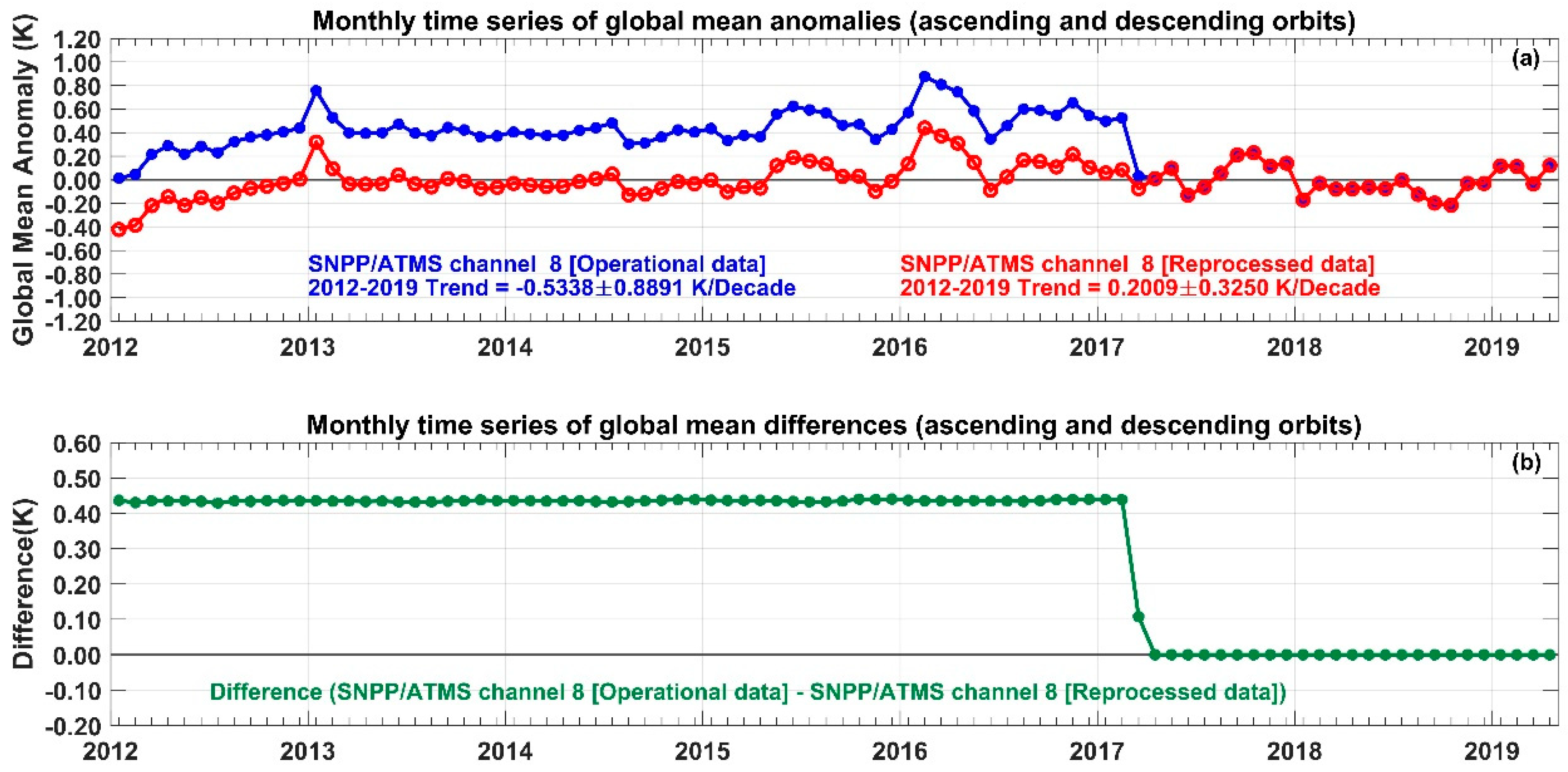

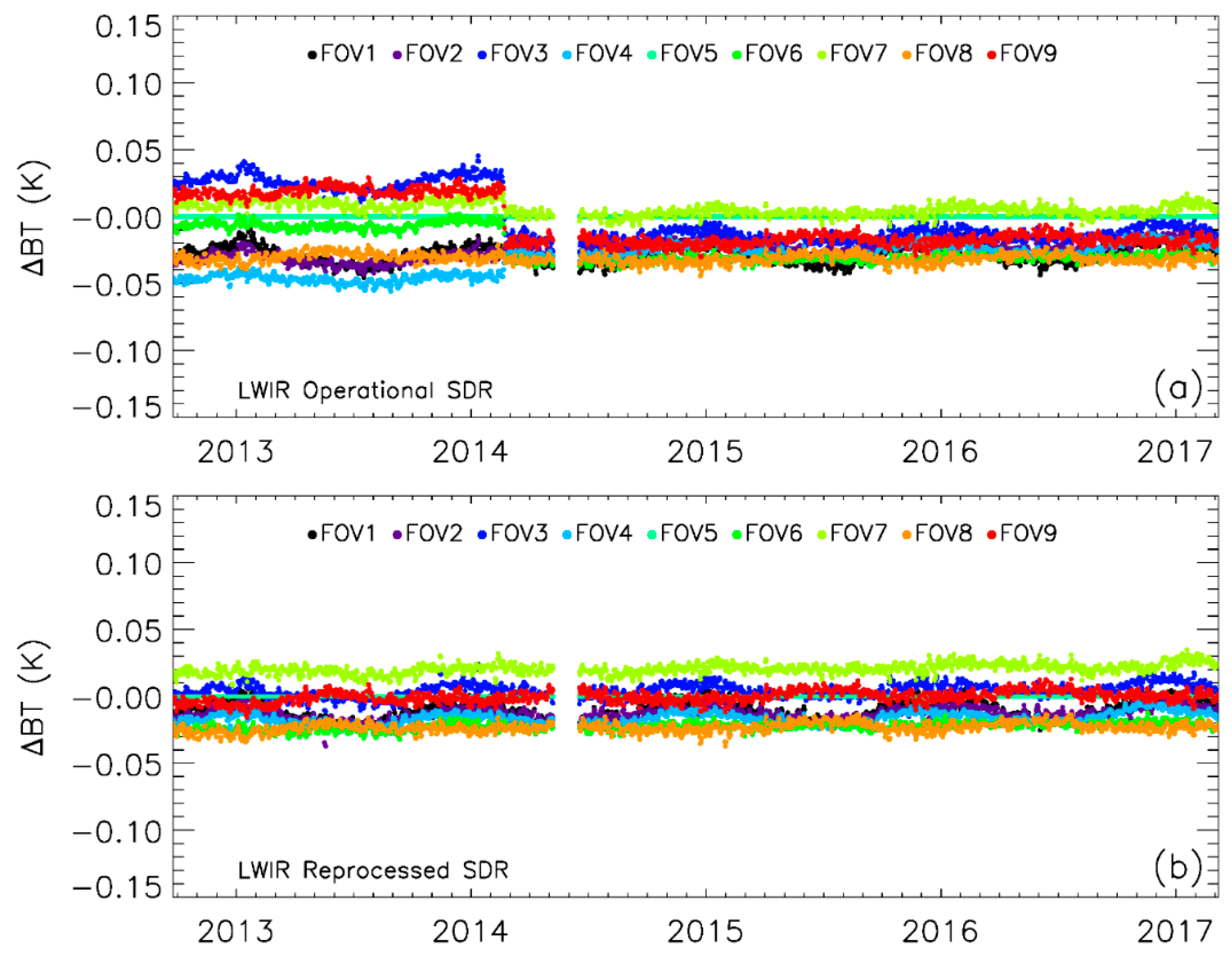
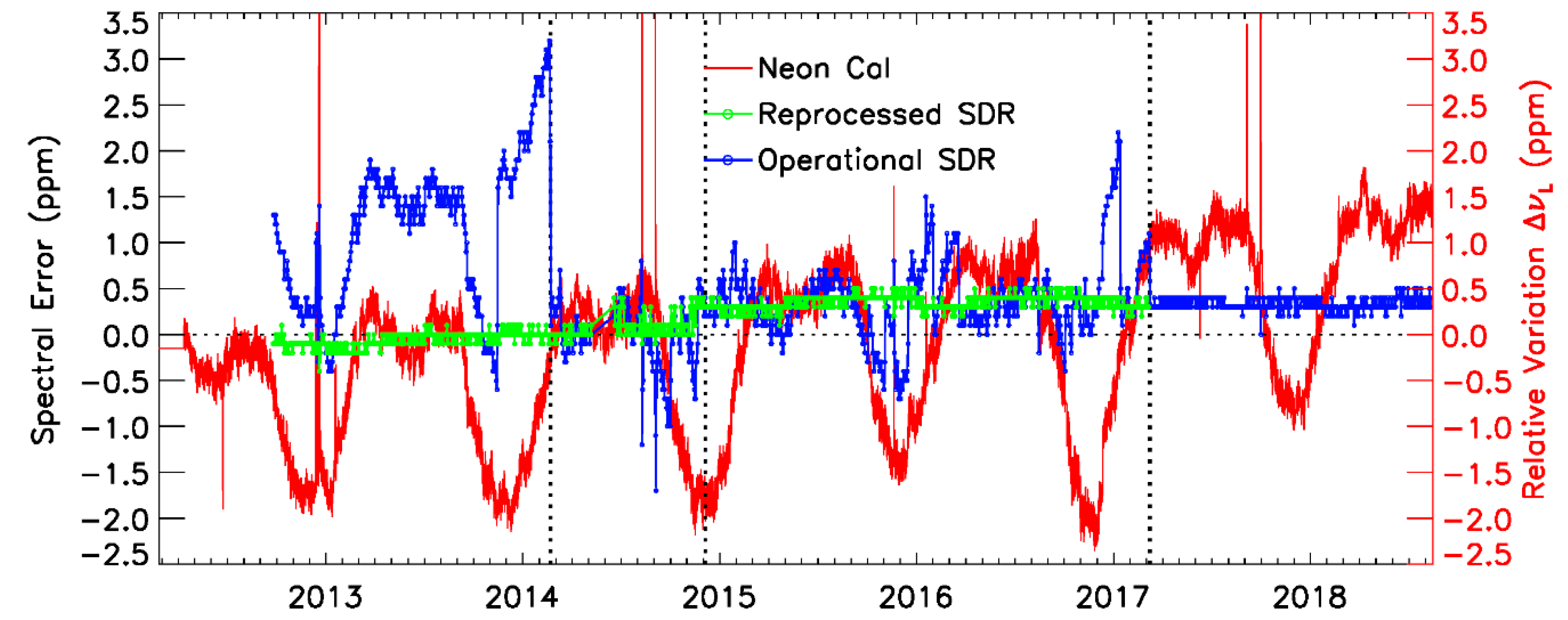


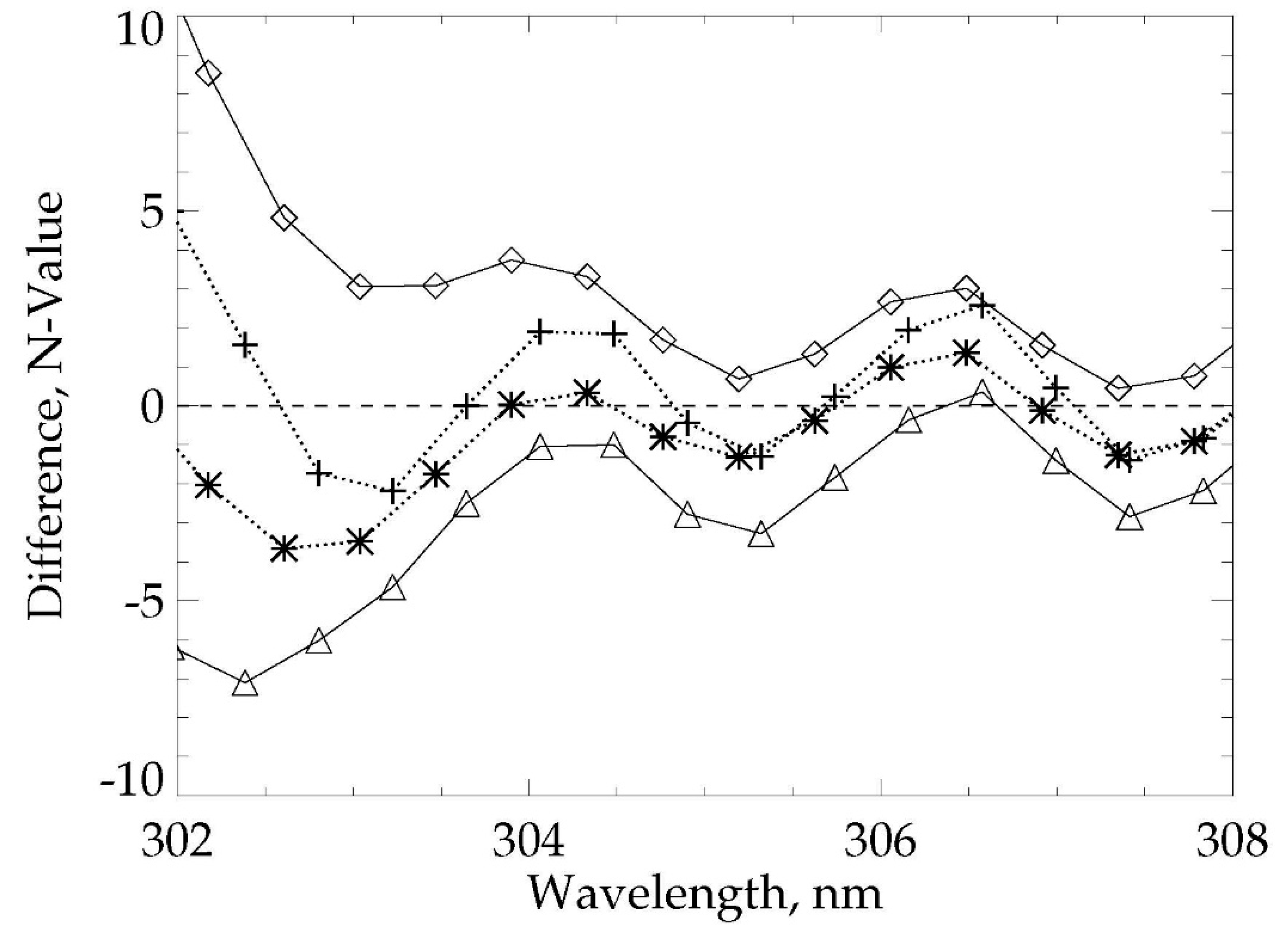



| ATMS Channel | Center Frequency (MHz) | Polarization | Maximum Bandwidth (MHz) | Calibration Accuracy (K) | 3-dB Bandwidth (deg) | Reference Channels |
|---|---|---|---|---|---|---|
| 1 | 23,800 | QV | 270 | 1.0 | 5.2 | AMSU-A Ch1 |
| 2 | 31,400 | QV | 180 | 1.0 | 5.2 | AMSU-A Ch2 |
| 3 | 50,300 | QH | 180 | 0.75 | 2.2 | AMSU-A Ch3 |
| 4 | 51,760 | QH | 400 | 0.75 | 2.2 | |
| 5 | 52,800 | QH | 400 | 0.75 | 2.2 | AMSU-A Ch4 |
| 6 | 53,596 ± 115 | QH | 170 | 0.75 | 2.2 | AMSU-A Ch5 |
| 7 | 54,400 | QH | 400 | 0.75 | 2.2 | AMSU-A Ch6 |
| 8 | 54,940 | QH | 400 | 0.75 | 2.2 | AMSU-A Ch7 |
| 9 | 55,500 | QH | 330 | 0.75 | 2.2 | AMSU-A Ch8 |
| 10 | 57,290.344(f0) | QH | 330 | 0.75 | 2.2 | AMSU-A Ch9 |
| 11 | fo ± 217 | QH | 78 | 0.75 | 2.2 | AMSU-A Ch10 |
| 12 | fo ± 322.2 ± 48 | QH | 36 | 0.75 | 2.2 | AMSU-A Ch11 |
| 13 | fo ± 322.2 ± 22 | QH | 16 | 0.75 | 2.2 | AMSU-A Ch12 |
| 14 | fo ± 322.2 ± 10 | QH | 8 | 0.75 | 2.2 | AMSU-A Ch13 |
| 15 | fo ± 322.2 ± 4.5 | QH | 3 | 0.75 | 2.2 | AMSU-A Ch14 |
| 16 | 88,200 | QV | 2000 | 1.0 | 2.2 | AMSU-B Ch16 |
| 17 | 165,500 | QH | 3000 | 1.0 | 1.1 | AMSU-B Ch17 |
| 18 | 183,310 ± 7000 | QH | 2000 | 1.0 | 1.1 | AMSU-B Ch20 |
| 19 | 183,310 ± 4500 | QH | 2000 | 1.0 | 1.1 | |
| 20 | 183,310 ± 3000 | QH | 1000 | 1.0 | 1.1 | AMSU-B Ch19 |
| 21 | 183,310 ± 1800 | QH | 1000 | 1.0 | 1.1 | |
| 22 | 183,310 ± 1000 | QH | 500 | 1.0 | 1.1 | AMSU-B Ch18 |
| Instrument | Frequency Band | Spectral Range (cm−1) | Number of In-Band Channels (Unapodized Channels) | Spectral Resolution (cm−1) | Effective Max. Path Difference (MPD) (cm) | Number of Channels with Guard Bands (Nb) | Decimation Factor (DFb) | NEdN (mW/m2/sr/cm−1) | Frequency Uncertainty (ppm) | Radiometric Uncertainty at 287 K BB (%) |
|---|---|---|---|---|---|---|---|---|---|---|
| NSR | LW | 650 to 1095 | 713 * (717) | 0.625 | 0.8 | 864 | 24 | 0.14 | 10 | 0.45 |
| MW | 1210 to 1750 | 433 * (437) | 1.25 | 0.4 | 528 | 20 | 0.06 | 10 | 0.58 | |
| SW | 2155 to 2550 | 159 * (163) | 2.5 | 0.2 | 200 | 26 | 0.007 | 10 | 0.77 | |
| FSR | LW | 650 to 1095 | 713 * (717) | 0.625 | 0.8 | 874 | 24 | 0.14 | 10 | 0.45 |
| MW | 1210 to 1750 | 865 * (869) | 0.625 | 0.8 | 1052 | 20 | 0.084 | 10 | 0.58 | |
| SW | 2155 to 2550 | 633 * (637) | 0.625 | 0.8 | 808 | 26 | 0.014 | 10 | 0.77 |
| Weekly Dark Current calibration started | 12/21/2012 |
| Stray light calibration LUT updates | 07/10/2013, 08/20/2013, 11/21/2014, 12/18/2014, 09/09/2015, 07/09/2018 |
| Observed Solar LUT update Wavelength calibration LUT update | 11/13/2014 |
| Solar LUT update Wavelength calibration LUT update Calibration constant update | 09/09/2015 |
| Wavelength calibration LUT updates | 6/26/2012, 7/22/2012, 8/19/2012, 10/23/2014, 09/09/2015 |
| Solar LUT updates | 07/17/2012, 09/09/2015, 04/20/2017 |
| Weekly Dark Current calibration started | 02/12/2013 |
| Stray light calibration LUT update | 03/18/2014 |
| Wavelength calibration LUT biweekly update started | 04/20/2017 |
| ViS/NIR | Band | M1 | M2 | M3 | M4 | I1 | M5 | M6 | I2 | M7 | |
| Wavelength (µm) | 0.412 | 0.445 | 0.488 | 0.555 | 0.640 | 0.672 | 0.746 | 0.865 | 0.865 | ||
| DNB | Band | DNB | |||||||||
| Wavelength (µm) | 0.5–0.9 | ||||||||||
| SW/MWIR | Band | M8 | M | I3 | M10 | M11 | I4 | M12 | M13 | ||
| Wavelength (µm) | 1.24 | 1.378 | 1.61 | 1.61 | 2.25 | 3.74 | 3.70 | 4.05 | |||
| LWIR | Band | M14 | M15 | I5 | M16 | ||||||
| Wavelength (µm) | 8.55 | 10.763 | 11.450 | 12.013 | |||||||
| MODIS Thermal Bands | Band | B20 | B22 | B29 | B31 | B32 | |||||
| Wavelength (µm) | 3.78 | 3.96 | 8.56 | 11.03 | 12.04 | ||||||
© 2020 by the authors. Licensee MDPI, Basel, Switzerland. This article is an open access article distributed under the terms and conditions of the Creative Commons Attribution (CC BY) license (http://creativecommons.org/licenses/by/4.0/).
Share and Cite
Zou, C.-Z.; Zhou, L.; Lin, L.; Sun, N.; Chen, Y.; Flynn, L.E.; Zhang, B.; Cao, C.; Iturbide-Sanchez, F.; Beck, T.; et al. The Reprocessed Suomi NPP Satellite Observations. Remote Sens. 2020, 12, 2891. https://doi.org/10.3390/rs12182891
Zou C-Z, Zhou L, Lin L, Sun N, Chen Y, Flynn LE, Zhang B, Cao C, Iturbide-Sanchez F, Beck T, et al. The Reprocessed Suomi NPP Satellite Observations. Remote Sensing. 2020; 12(18):2891. https://doi.org/10.3390/rs12182891
Chicago/Turabian StyleZou, Cheng-Zhi, Lihang Zhou, Lin Lin, Ninghai Sun, Yong Chen, Lawrence E. Flynn, Bin Zhang, Changyong Cao, Flavio Iturbide-Sanchez, Trevor Beck, and et al. 2020. "The Reprocessed Suomi NPP Satellite Observations" Remote Sensing 12, no. 18: 2891. https://doi.org/10.3390/rs12182891
APA StyleZou, C.-Z., Zhou, L., Lin, L., Sun, N., Chen, Y., Flynn, L. E., Zhang, B., Cao, C., Iturbide-Sanchez, F., Beck, T., Yan, B., Kalluri, S., Bai, Y., Blonski, S., Choi, T., Divakarla, M., Gu, Y., Hao, X., Li, W., ... Goldberg, M. D. (2020). The Reprocessed Suomi NPP Satellite Observations. Remote Sensing, 12(18), 2891. https://doi.org/10.3390/rs12182891









